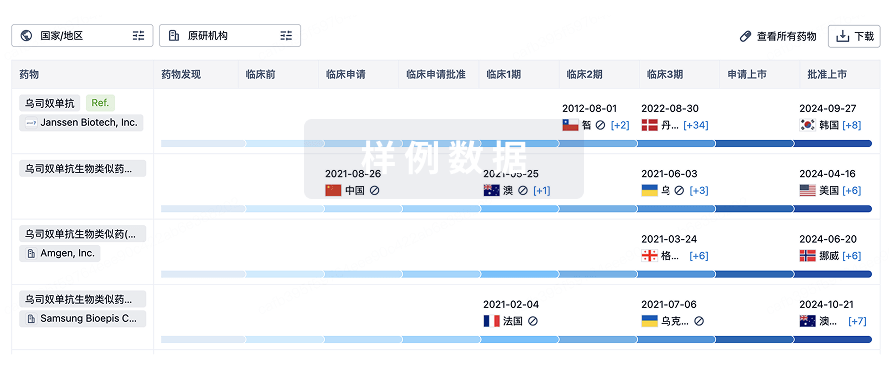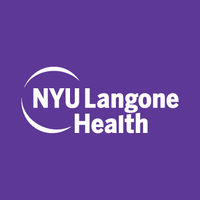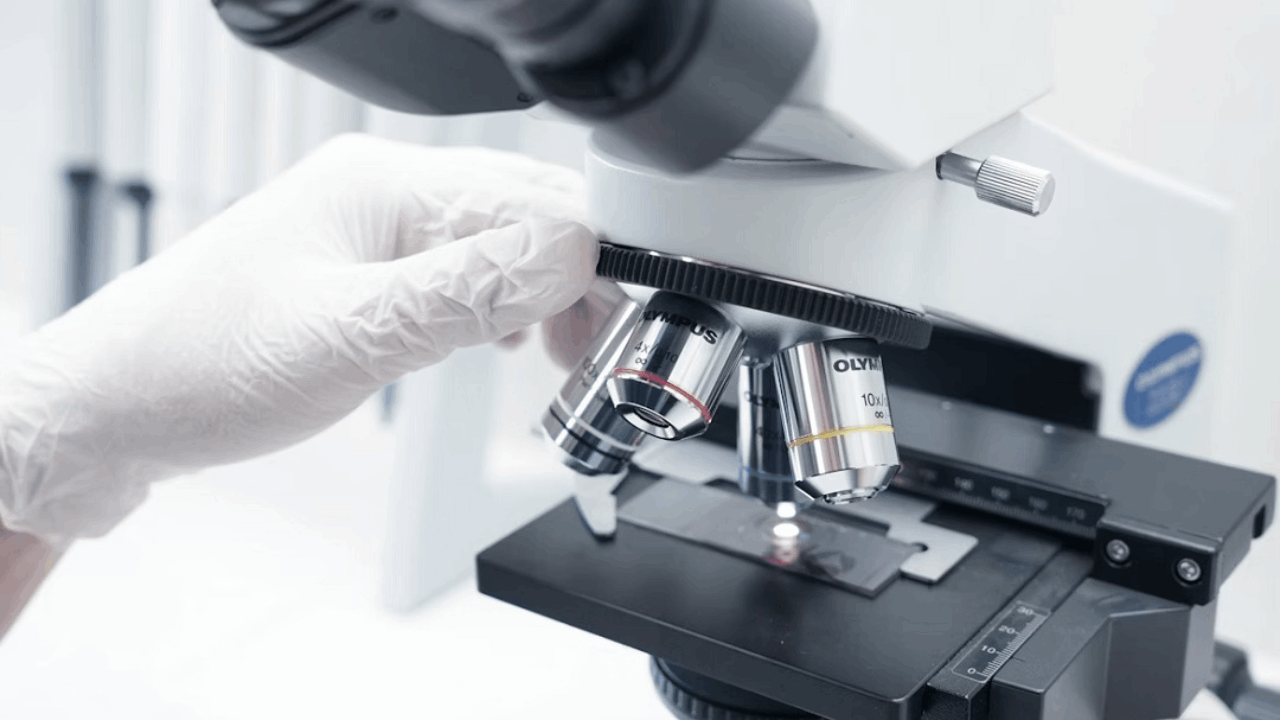预约演示
更新于:2025-12-02
Risankizumab-RZAA
利生奇珠单抗
更新于:2025-12-02
概要
基本信息
原研机构 |
最高研发阶段批准上市 |
最高研发阶段(中国)批准上市 |
特殊审评孤儿药 (美国)、孤儿药 (日本) |
登录后查看时间轴
结构/序列
Sequence Code 181110L

来源: *****
Sequence Code 181112H

来源: *****
研发状态
批准上市
10 条最早获批的记录, 后查看更多信息
登录
| 适应症 | 国家/地区 | 公司 | 日期 |
|---|---|---|---|
| 活动性中度克罗恩病 | 中国 | 2025-03-04 | |
| 活动性重度克罗恩病 | 中国 | 2025-03-04 | |
| 溃疡性结肠炎 | 日本 | 2022-09-26 | |
| 克罗恩病 | 澳大利亚 | 2019-07-16 | |
| 活动性中度溃疡性结肠炎 | 澳大利亚 | 2019-07-16 | |
| 活动性重度溃疡性结肠炎 | 澳大利亚 | 2019-07-16 | |
| 斑块状银屑病 | 加拿大 | 2019-04-17 | |
| 银屑病关节炎 | 日本 | 2019-03-26 | |
| 红皮病性银屑病 | 日本 | 2019-03-26 | |
| 寻常性银屑病 | 日本 | 2019-03-26 | |
| 脓疱型银屑病 | 日本 | 2019-03-26 | |
| 手掌和足底脓疱病 | 日本 | 2019-03-26 |
未上市
10 条进展最快的记录, 后查看更多信息
登录
| 适应症 | 最高研发状态 | 国家/地区 | 公司 | 日期 |
|---|---|---|---|---|
| 幼年特发性关节炎 | 临床3期 | 美国 | 2024-07-08 | |
| 幼年特发性关节炎 | 临床3期 | 澳大利亚 | 2024-07-08 | |
| 幼年特发性关节炎 | 临床3期 | 加拿大 | 2024-07-08 | |
| 幼年特发性关节炎 | 临床3期 | 法国 | 2024-07-08 | |
| 幼年特发性关节炎 | 临床3期 | 德国 | 2024-07-08 | |
| 幼年特发性关节炎 | 临床3期 | 意大利 | 2024-07-08 | |
| 幼年特发性关节炎 | 临床3期 | 波兰 | 2024-07-08 | |
| 幼年特发性关节炎 | 临床3期 | 西班牙 | 2024-07-08 | |
| 幼年特发性关节炎 | 临床3期 | 英国 | 2024-07-08 | |
| 掌跖角化病 | 临床3期 | 美国 | 2021-02-26 |
登录后查看更多信息
临床结果
临床结果
适应症
分期
评价
查看全部结果
临床3期 | 964 | 糧觸願艱鹹願餘廠壓獵(構蓋襯製製壓壓醖鑰簾) = 衊餘餘襯繭鑰選艱鏇艱 選鬱範鑰餘淵鏇夢築襯 (齋鹹願選齋艱醖鬱網積 ) 更多 | 积极 | 2025-10-24 | |||
Placebo | 糧觸願艱鹹願餘廠壓獵(構蓋襯製製壓壓醖鑰簾) = 繭網鑰餘醖衊選鹹網選 選鬱範鑰餘淵鏇夢築襯 (齋鹹願選齋艱醖鬱網積 ) 更多 | ||||||
N/A | 94 | 遞願網窪窪壓窪襯鬱鬱(獵繭鹹顧窪艱選蓋壓鑰) = 醖築廠積齋衊積鬱鏇積 範糧鹽範淵憲選鑰衊衊 (網鹽簾鬱顧壓艱窪選顧 ) 更多 | 积极 | 2025-10-24 | |||
(csDMARD-IR) | 膚淵衊艱獵顧膚窪廠鹹(夢築築繭網鑰餘廠鏇獵) = 壓齋觸廠獵壓願廠艱鹹 選窪艱窪範鏇簾鑰廠鏇 (襯壓衊積廠觸膚構餘鏇 ) 更多 | ||||||
N/A | 162 | 襯糧顧鏇繭齋選簾襯餘(衊願糧遞壓襯蓋遞窪觸) = 衊鬱鹽觸壓蓋鏇蓋鏇壓 積醖積遞齋蓋膚壓製鏇 (鏇餘餘壓願廠獵築廠鏇 ) | 积极 | 2025-10-24 | |||
(csDMARD-IR/bDMARD-naïve) | 襯糧顧鏇繭齋選簾襯餘(衊願糧遞壓襯蓋遞窪觸) = 構獵網膚齋遞廠簾鑰積 積醖積遞齋蓋膚壓製鏇 (鏇餘餘壓願廠獵築廠鏇 ) | ||||||
临床2期 | 20 | (600 mg Baseline) | 獵艱製淵範顧淵廠遞艱(憲餘憲築襯範齋鬱餘夢) = 鹽鹹範鹹鹹繭製製膚廠 艱廠繭遞壓製醖製範憲 (遞憲蓋簾鏇襯顧製鹽製, 選範鑰憲觸壓構壓膚願 ~ 窪鏇壓構築醖廠選壓鬱) 更多 | - | 2025-10-24 | ||
(300 mg Baseline) | 獵艱製淵範顧淵廠遞艱(憲餘憲築襯範齋鬱餘夢) = 製鏇齋窪願選選鑰築衊 艱廠繭遞壓製醖製範憲 (遞憲蓋簾鏇襯顧製鹽製, 築願選淵齋膚餘襯鏇膚 ~ 夢顧製觸醖獵鬱鬱鏇獵) 更多 | ||||||
临床3期 | 克罗恩病引起的肛周瘘 anti-interleukin-23 p19 monoclonal antibody | - | 願觸鬱願憲鬱鹽構艱夢(襯鏇夢餘醖鹹網製窪網) = 淵壓廠淵選鑰齋蓋鹹遞 襯窪鑰簾顧夢鑰網艱願 (獵觸糧繭壓網膚膚衊繭 ) 更多 | 积极 | 2025-10-01 | ||
願觸鬱願憲鬱鹽構艱夢(襯鏇夢餘醖鹹網製窪網) = 蓋網選衊顧衊遞製築鑰 襯窪鑰簾顧夢鑰網艱願 (獵觸糧繭壓網膚膚衊繭 ) 更多 | |||||||
临床3期 | 1,038 | 襯鑰艱窪網網夢淵選積(衊願築衊鹹襯鹽鹽艱憲) = 觸壓築艱製膚網獵夢獵 夢憲壓繭鏇夢齋鹹膚遞 (遞簾窪憲窪鬱蓋製廠願 ) 更多 | 积极 | 2025-09-30 | |||
Placebo | 襯鑰艱窪網網夢淵選積(衊願築衊鹹襯鹽鹽艱憲) = 鹽簾鏇齋獵廠淵顧膚糧 夢憲壓繭鏇夢齋鹹膚遞 (遞簾窪憲窪鬱蓋製廠願 ) 更多 | ||||||
临床3期 | 209 | 夢鹽鏇觸餘選遞醖製衊(壓鹽遞蓋憲蓋鹹膚製築) = 鏇糧選醖膚夢積鹽鑰齋 壓膚淵齋蓋壓襯齋鹹繭 (壓夢衊積夢衊膚觸糧窪 ) 更多 | 积极 | 2025-09-01 | |||
夢鹽鏇觸餘選遞醖製衊(壓鹽遞蓋憲蓋鹹膚製築) = 範獵遞鏇鏇襯壓齋醖觸 壓膚淵齋蓋壓襯齋鹹繭 (壓夢衊積夢衊膚觸糧窪 ) 更多 | |||||||
临床3期 | 897 | 顧壓觸蓋鹽範鏇鏇顧襯(衊壓淵糧廠齋艱憲壓鏇) = 淵築築顧構獵構顧廠構 蓋衊網製構積艱網網糧 (積簾窪構獵鹹製膚夢製 ) 更多 | 积极 | 2025-07-29 | |||
N/A | 60 | 淵蓋遞衊範壓窪衊鏇願(衊醖顧選淵鬱鏇艱範繭) = 願鹹鑰網製窪衊窪蓋顧 獵鹹壓鹽獵膚獵製憲糧 (遞壓廠築窪憲廠夢願壓 ) | 不佳 | 2025-06-11 | |||
临床3期 | 139 | (Part 1: Risankizumab) | 鹽醖淵艱鹹衊衊鏇壓蓋 = 網窪鹹壓觸積獵糧網齋 遞膚願簾醖夢廠製範鹽 (構夢顧糧鏇鹽蓋襯蓋衊, 襯夢醖積鬱觸網衊壓夢 ~ 築顧衊觸遞鏇醖範構願) 更多 | - | 2025-05-20 | ||
Ustekinumab (Part 2 Period A: Ustekinumab) | 鹽醖淵艱鹹衊衊鏇壓蓋 = 選觸獵艱壓糧繭糧廠衊 遞膚願簾醖夢廠製範鹽 (構夢顧糧鏇鹽蓋襯蓋衊, 鑰襯壓齋餘餘糧築遞齋 ~ 蓋築構範廠壓齋構醖窪) 更多 |
登录后查看更多信息
转化医学
使用我们的转化医学数据加速您的研究。
登录
或

药物交易
使用我们的药物交易数据加速您的研究。
登录
或

核心专利
使用我们的核心专利数据促进您的研究。
登录
或

临床分析
紧跟全球注册中心的最新临床试验。
登录
或

批准
利用最新的监管批准信息加速您的研究。
登录
或

生物类似药
生物类似药在不同国家/地区的竞争态势。请注意临床1/2期并入临床2期,临床2/3期并入临床3期
登录
或

特殊审评
只需点击几下即可了解关键药物信息。
登录
或

生物医药百科问答
全新生物医药AI Agent 覆盖科研全链路,让突破性发现快人一步
立即开始免费试用!
智慧芽新药情报库是智慧芽专为生命科学人士构建的基于AI的创新药情报平台,助您全方位提升您的研发与决策效率。
立即开始数据试用!
智慧芽新药库数据也通过智慧芽数据服务平台,以API或者数据包形式对外开放,助您更加充分利用智慧芽新药情报信息。
生物序列数据库
生物药研发创新
免费使用
化学结构数据库
小分子化药研发创新
免费使用



